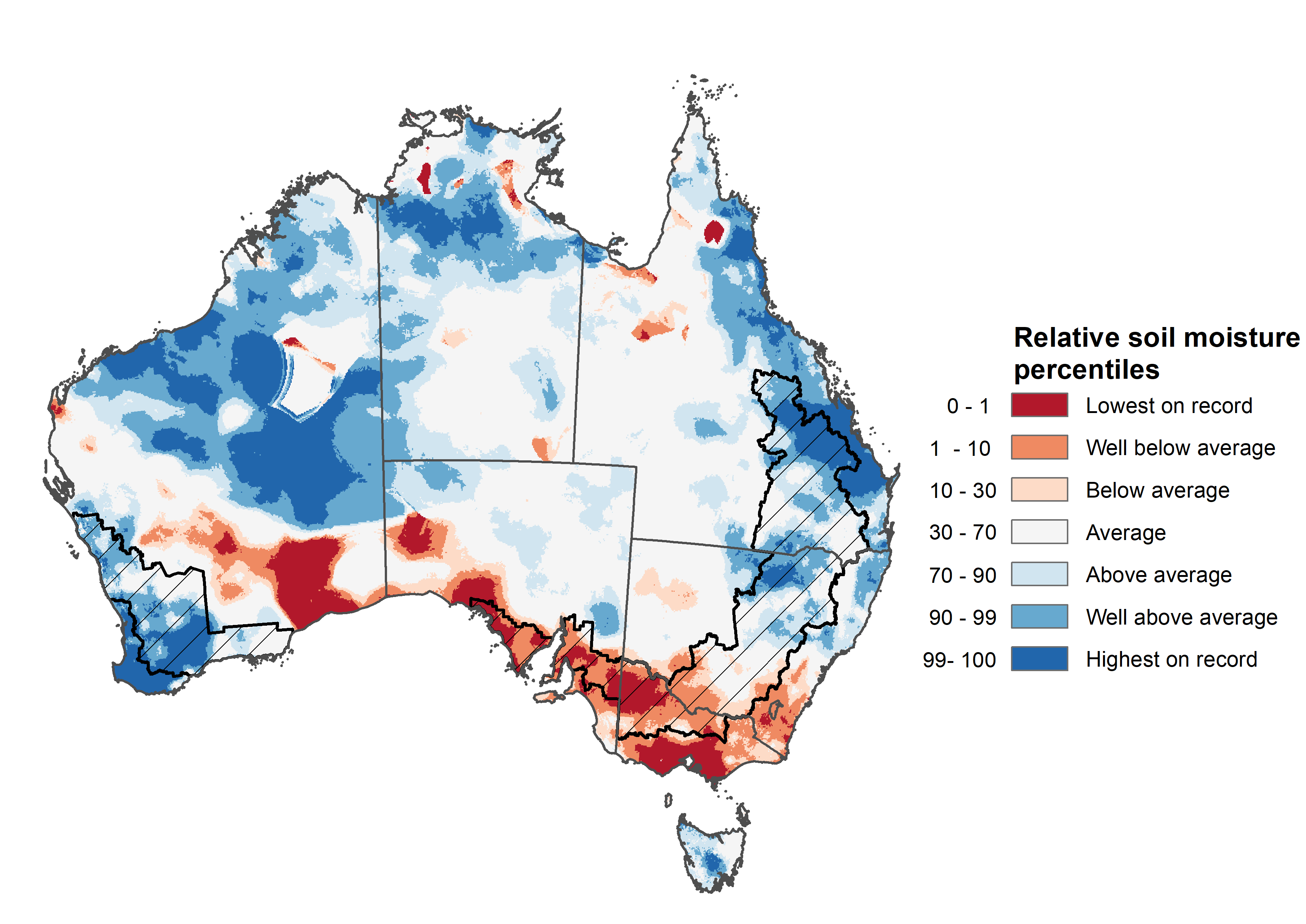Key issues
- In the week ending 4 September 2024, cold fronts and low-pressure systems brough rainfall in some areas in the south, with central and northern regions mainly dry.
- Across cropping regions, rainfall totals ranged from 5 to 10 millimetres across Western Australia, South Australia and central Victoria, with up to 25 millimetres of rainfall recorded in isolated areas of south Victoria.
- Over coming days, cold fronts are expected to bring showers to the northern and southern parts of the country, including Tasmania. High-pressure systems are expected to keep the central parts of the country largely dry.
- Across cropping regions, rainfall totals of between 10 and 25 millimetres are forecast across Western Australia and New South Wales. Some regions in Victoria and South Australia are expected to receive up to 50 millimetres of rainfall, with falls of between 5 and 10 millimetres expected in most regions. If realised, this rainfall is expected to support the growth of crops and pastures in southern regions, with crops in Queensland to draw on stored soil moisture to support growth.
- Nationally, August rainfall was high in the south-west and eastern parts of the country. Below average rainfall was recorded in central and northern Australia and parts of the south-east.
- Soil moisture models suggest low soil moisture in south-eastern Australia, with high soil moisture modelled in eastern Queensland, northern New South Wales, and large parts of Western Australia and the Northern Territory.
- For the 3 months to August 2024, above average rainfall totals resulted in average to extremely high pasture production across large parts of eastern, western, and central Australia. Below average to extremely low pasture growth was recorded in southern areas and isolated regions in the east.
- Water storage levels in the Murray-Darling Basin (MDB) increased between 29 August 2024 and 05 September 2024 by 33 gigalitres (GL). The current volume of water held in storage is 18 423 GL, equivalent to 83% of total storage capacity. This is 10% or 2,443GL less than at the same time last year. Water storage data is sourced from the BOM.
- Allocation prices in the Victorian Murray below the Barmah Choke remained at $147 between 29 August 2024 and 05 September 2024. Prices are lower in the Murrumbidgee due to the binding of the Murrumbidgee export limit.
Climate
For the week ending 4 September 2024, a series of cold fronts and low-pressure systems brought rainfall to some areas in the southern half of the country, with central and northern regions largely dry. Rainfall totals of up to 300 millimetres were recorded in western Tasmania, with the south-west Western Australia, southern Victoria and south-east of South Australia recording falls of between 5 and 50 millimetres.
Across cropping regions, little to no rainfall was recorded across most areas this week. The main exceptions were falls ranging between 1 to 10 millimetres in Western Australia and parts of South Australia and southern Victoria. Little to no rainfall across south-eastern and eastern cropping regions has contributed to a drawdown of stored soil moisture. Where average to above average levels of stored soil moisture are available, crops and pastures would have been able to draw on these reserves to maintain current yield potentials. However, in areas where stored soil moisture levels are low, little to no rainfall is likely to lead to reduced yield potential, exacerbated by warm and windy conditions in some areas.
Rainfall for the week ending 4 September 2024

Issued: 04/09/2024
Note: The rainfall analyses and associated maps utilise data contained in the Bureau of Meteorology climate database, the Australian Data Archive for Meteorology (ADAM). The analyses are initially produced automatically from real-time data with limited quality control. They are intended to provide a general overview of rainfall across Australia as quickly as possible after the observations are received. For further information go to http://www.bom.gov.au/climate/rainfall/
Over the 8 days to 12 September 2024, cold fronts and low-pressure systems are expected to bring showers over the northern and southern parts of the country. High-pressure systems are expected to keep some central areas largely dry.
Across cropping regions, rainfall totals of between 10 and 25 millimetres are forecast across most of Western Australia and New South Wales. Victoria and South Australia are forecast to receive between 15 and 25 millimetres of rainfall across most regions, with isolated areas expected to receive up to 50 millimetres. Rainfall totals in Queensland are forecast to be relatively low, with between 5 and 10 millimetres of rainfall expected across cropping regions.
If realised, this rainfall is expected to support the growth of crops and pastures in southern regions, with crops in Queensland to draw on stored soil moisture to support growth.
Total forecast rainfall for the period 5 September to 12 September 2024

Issued 05/09/2024
Note: This rainfall forecast is produced from computer models. As the model outputs are not altered by weather forecasters, it is important to check local forecasts and warnings issued by the Bureau of Meteorology.
During August 2024, rainfall was well above average across large parts of Tasmania, central and south-western Western Australia, eastern Queensland and the north-east of New South Wales. Much of the remainder of northern Australia saw generally average rainfall in August consistent with the northern dry season. In contrast, Victoria, and large areas of southern South Australia and southern New South Wales recorded well below average rainfall.
In cropping regions, August 2024 rainfall was mixed, with much of Western Australia, Queensland and New South Wales experiencing average to extremely high rainfall. In contrast, Victoria, South Australia and parts of southern New South Wales recorded extremely low to below average rainfall.
Following below average to average rainfall in the previous month across much of Victoria and South Australia, August rainfall totals have unlikely been sufficient to support winter crops growth. This has led to a drawdown of soil moisture reserves to maintain crops growth through winter. By contrast, the average to extremely high rainfall totals recorded across Queensland, Western Australia, and much of New South Wales, has allowed for the build-up of soil moisture to support the crop development and maintain average to above average yield expectations.
Rainfall percentiles for August 2024

Source: Bureau of Meteorology
While modelled upper layer soil moisture levels for August 2024 varied considerably, much of the country saw average to well above average soil moisture. High levels of upper layer soil moisture were modelled in eastern Queensland, northern New South Wales, the north of the Northern Territory, central Tasmania and large parts of central and south-western Western Australia. In contrast, upper layer soil moisture was modelled to be well below average across much of Victoria and southern South Australia.
At this time of year, upper layer soil moisture is less critical for well-established winter crops. However, upper layer soil moisture will be critical for supporting the germination and establishment of summer crops in the coming months.
Across cropping regions, upper layer soil moisture in August was modelled to be generally above average in western and northern regions – parts of northern Queensland and southern Western Australia were modelled to have well above average soil moisture. Remaining parts of Western Australia, Queensland, and northern New South Wales were modelled to have average to above average soil moisture. Average to well below average soil moisture was recorded across South Australia, Victoria, and southern New South Wales. Timely rainfall in the coming weeks will be critical to support the development and yield prospects of winter crops across south-eastern growing regions.
Modelled upper layer soil moisture for August 2024

Source: Bureau of Meteorology (Australian Water Resources Assessment Landscape model
Across northern Australia, lower layer soil moisture was average to well above average, with scattered parts of eastern Queensland and central Western Australia seeing the highest moisture on record levels for this time of year. In contrast, the far south-east of Australia was modelled to have generally below average lower layer soil moisture. Modelled lower layer soil moisture was generally average to above average for remaining areas of Australia.
Lower layer soil moisture plays a pivotal role in sustaining the growth of winter crops and pasture during their critical development stages.
Across cropping regions, lower layer soil moisture generally ranged from average to above average in the east, with Queensland and much of New South Wales showing average to well above average soil moisture. In Western Australia, soil moisture was modelled to be average to below average in the eastern and central areas, and above average in the north-west. In South Australia, Victoria, and southern New South Wales, August lower layer soil moisture was modelled to be below average to well below average for this time of year. Cropping regions in far south-eastern Australia with extremely low levels of stored soil moisture will require sufficient and timely rainfall during spring to achieve the current forecast levels of crop and livestock production for 2024–25.
Modelled lower layer soil moisture for August 2024

Source: Bureau of Meteorology (Australian Water Resources Assessment Landscape model)
During the northern Australia dry season (May to September), pasture growth typically declines significantly due to the reduction in water availability, with livestock relying on pasture grown throughout the previous wet season. During winter, pasture growth typically increases in southern Australia, reflecting higher rainfall totals, and reduced temperatures and evapotranspiration rates at this time of year. Pasture availability during this period influences the growth and branding and marking rates of lambs and calves, livestock turnoff and the production of meat, milk, and wool.
For the 3 months to August 2024, average to extremely high pasture growth relative to this time of year was across much of New South Wales, central and southern Victoria, large areas of Queensland, eastern Tasmania, much of Western Australia, southern Northern Territory and in scattered areas of South Australia. This growth is likely to enable farmers to continue to maintain stock numbers and provide opportunities to build standing dry matter availability and replenish fodder supplies during spring.
In contrast, below average to extremely low pasture growth rates were recorded across the south and east of the country. Large areas of southern South Australia and northern Victoria, central parts of Queensland and central New South Wales and parts of southern Western Australia, all saw below average to well below average pasture growth. Graziers in regions where below average pasture growth was recorded will be more reliant on supplemental feed to maintain current stocking rates and production.
Relative pasture growth for 3-months ending August 2024 (1 June to 31 August 2024)

Source: Department of Environment, Science and Innovation
Water
Water storages, water markets and water allocations - current week
The Tableau dashboard may not meet accessibility requirements. For information about the contents of these dashboards contact ABARES.
Commodities
Information on weekly price changes in agricultural commodities is now available at the Weekly commodity price update.
